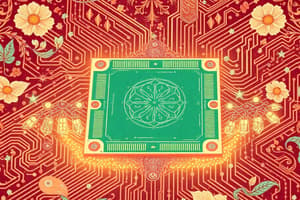Podcast
Questions and Answers
Match the following computer network types with their typical scope:
Match the following computer network types with their typical scope:
LAN = Connects devices in a limited area, such as a home or office WAN = Connects devices over a large geographical area VPN = Creates a secure, private connection over a public network WLAN = Uses wireless communication to connects deivces within a limited area
Match the following Internet-related terms with their meanings:
Match the following Internet-related terms with their meanings:
IP Address = A unique numerical label assigned to each device on a network DNS = Translates domain names to IP addresses URL = A formatted text string used to identify a network resource Firewall = A network security system that monitors and controls incoming and outgoing network traffic
Match the following number systems with their bases:
Match the following number systems with their bases:
Binary = Base 2 Octal = Base 8 Decimal = Base 10 Hexadecimal = Base 16
Match each programming language to its typical use case:
Match each programming language to its typical use case:
Match the security measures to the threats they mitigate:
Match the security measures to the threats they mitigate:
Match the file extensions to the type of file they represent:
Match the file extensions to the type of file they represent:
Match the different cloud computing models with their descriptions:
Match the different cloud computing models with their descriptions:
Flashcards
What is Hardware?
What is Hardware?
Physical components of a computer system.
What is the CPU?
What is the CPU?
The 'brain' of the computer, processing instructions.
What is Memory (RAM)?
What is Memory (RAM)?
Temporary storage for data and programs in use.
What are Storage Devices?
What are Storage Devices?
Signup and view all the flashcards
What are Input Devices?
What are Input Devices?
Signup and view all the flashcards
What are Output Devices?
What are Output Devices?
Signup and view all the flashcards
What is Software?
What is Software?
Signup and view all the flashcards
What is System Software?
What is System Software?
Signup and view all the flashcards
What is Application Software?
What is Application Software?
Signup and view all the flashcards
What is the Data Processing Cycle?
What is the Data Processing Cycle?
Signup and view all the flashcards
What are Computer Languages?
What are Computer Languages?
Signup and view all the flashcards
What are the two levels of computer language?
What are the two levels of computer language?
Signup and view all the flashcards
What are Computer Networks?
What are Computer Networks?
Signup and view all the flashcards
What is Data?
What is Data?
Signup and view all the flashcards
What is Information?
What is Information?
Signup and view all the flashcards
Study Notes
- ระบบคอมพิวเตอร์ประกอบด้วยส่วนประกอบที่ทำงานร่วมกันเพื่อประมวลผลข้อมูลและดำเนินการตามคำสั่ง
- ส่วนประกอบหลัก ได้แก่ ฮาร์ดแวร์และซอฟต์แวร์
ฮาร์ดแวร์ (Hardware)
- ฮาร์ดแวร์คือส่วนประกอบทางกายภาพของคอมพิวเตอร์
- ตัวอย่างฮาร์ดแวร์ ได้แก่ CPU, หน่วยความจำ, อุปกรณ์จัดเก็บข้อมูล, อุปกรณ์อินพุต, อุปกรณ์เอาต์พุต
- หน่วยประมวลผลกลาง (CPU):
- CPU เปรียบเสมือนสมองของคอมพิวเตอร์
- ทำหน้าที่ประมวลผลคำสั่งและควบคุมการทำงานของส่วนประกอบอื่น ๆ
- ความเร็วของ CPU มีผลต่อประสิทธิภาพโดยรวมของคอมพิวเตอร์
- หน่วยความจำ (Memory):
- หน่วยความจำใช้สำหรับจัดเก็บข้อมูลและโปรแกรมที่กำลังใช้งานอยู่ชั่วคราว
- RAM (Random Access Memory) เป็นหน่วยความจำหลักที่เข้าถึงข้อมูลได้รวดเร็ว
- ROM (Read-Only Memory) เป็นหน่วยความจำที่เก็บข้อมูลถาวร
- อุปกรณ์จัดเก็บข้อมูล (Storage Devices):
- ใช้สำหรับจัดเก็บข้อมูลและโปรแกรมอย่างถาวร
- ตัวอย่าง ได้แก่ ฮาร์ดดิสก์ (HDD), โซลิดสเตตไดรฟ์ (SSD), แฟลชไดรฟ์
- SSD เร็วกว่า HDD แต่มีราคาแพงกว่าต่อความจุ
- อุปกรณ์อินพุต (Input Devices):
- ใช้สำหรับนำเข้าข้อมูลเข้าสู่คอมพิวเตอร์
- ตัวอย่าง ได้แก่ คีย์บอร์ด, เมาส์, สแกนเนอร์, ไมโครโฟน
- อุปกรณ์เอาต์พุต (Output Devices):
- ใช้สำหรับแสดงผลหรือส่งออกข้อมูลจากคอมพิวเตอร์
- ตัวอย่าง ได้แก่ จอภาพ, เครื่องพิมพ์, ลำโพง
ซอฟต์แวร์ (Software)
- ซอฟต์แวร์คือชุดคำสั่งหรือโปรแกรมที่สั่งให้ฮาร์ดแวร์ทำงาน
- แบ่งออกเป็น 2 ประเภทหลัก คือ ซอฟต์แวร์ระบบและซอฟต์แวร์ประยุกต์
- ซอฟต์แวร์ระบบ (System Software):
- ทำหน้าที่จัดการและควบคุมการทำงานของฮาร์ดแวร์และซอฟต์แวร์อื่น ๆ
- ตัวอย่าง ได้แก่ ระบบปฏิบัติการ (Operating System), ไดรเวอร์ (Drivers), โปรแกรมอรรถประโยชน์ (Utilities)
- ระบบปฏิบัติการ (Operating System):
- เป็นซอฟต์แวร์หลักที่ทำหน้าที่เป็นตัวกลางระหว่างผู้ใช้และฮาร์ดแวร์
- ตัวอย่างระบบปฏิบัติการ ได้แก่ Windows, macOS, Linux
- ซอฟต์แวร์ประยุกต์ (Application Software):
- ออกแบบมาเพื่อทำงานเฉพาะอย่างตามความต้องการของผู้ใช้
- ตัวอย่าง ได้แก่ โปรแกรมประมวลผลคำ (Word processors), โปรแกรมสเปรดชีต (Spreadsheets), โปรแกรมนำเสนอ (Presentation software), เว็บเบราว์เซอร์ (Web browsers)
การทำงานของระบบคอมพิวเตอร์
- ระบบคอมพิวเตอร์ทำงานตามหลักการพื้นฐานคือ รับข้อมูล (Input), ประมวลผล (Process), แสดงผล (Output), และจัดเก็บ (Storage)
- วงจรการทำงานนี้เรียกว่า "วงจรการประมวลผลข้อมูล" (Data Processing Cycle)
ภาษาคอมพิวเตอร์
- ภาษาคอมพิวเตอร์ใช้สำหรับเขียนโปรแกรมเพื่อให้คอมพิวเตอร์เข้าใจและทำงานตามที่ต้องการ
- มีหลายระดับ ตั้งแต่ภาษาระดับต่ำ (Low-level languages) ไปจนถึงภาษาระดับสูง (High-level languages)
- ภาษาระดับต่ำ:
- ใกล้เคียงกับภาษาเครื่อง (Machine language) ที่คอมพิวเตอร์เข้าใจโดยตรง
- ตัวอย่าง ได้แก่ ภาษาแอสเซมบลี (Assembly language)
- ภาษาระดับสูง:
- เข้าใจง่ายและใกล้เคียงกับภาษามนุษย์
- ต้องใช้ตัวแปลภาษา (Translator) เพื่อแปลงเป็นภาษาเครื่อง
- ตัวอย่าง ได้แก่ C, C++, Java, Python
เครือข่ายคอมพิวเตอร์
- เครือข่ายคอมพิวเตอร์คือการเชื่อมต่อคอมพิวเตอร์และอุปกรณ์ต่าง ๆ เพื่อให้สามารถสื่อสารและแลกเปลี่ยนข้อมูลกันได้
- มีหลายประเภท เช่น LAN (Local Area Network), WAN (Wide Area Network)
- อินเทอร์เน็ต (Internet) เป็นเครือข่ายคอมพิวเตอร์ขนาดใหญ่ที่เชื่อมต่อเครือข่ายทั่วโลกเข้าด้วยกัน
- โปรโตคอล (Protocols) เป็นชุดกฎเกณฑ์ที่ใช้ในการสื่อสารระหว่างคอมพิวเตอร์ในเครือข่าย
- TCP/IP เป็นชุดโปรโตคอลหลักที่ใช้ในอินเทอร์เน็ต
ระบบจำนวน
- คอมพิวเตอร์ใช้ระบบเลขฐานสอง (Binary number system) ในการแทนข้อมูล
- เลขฐานสองประกอบด้วยเลข 0 และ 1 เท่านั้น
- นอกจากนี้ยังมีระบบเลขฐานแปด (Octal), ฐานสิบ (Decimal), และฐานสิบหก (Hexadecimal) ที่ใช้ในคอมพิวเตอร์
ข้อมูลและสารสนเทศ
- ข้อมูล (Data) คือข้อเท็จจริงหรือสัญลักษณ์ที่ยังไม่ได้ผ่านการประมวลผล
- สารสนเทศ (Information) คือข้อมูลที่ผ่านการประมวลผลและมีความหมายต่อผู้ใช้
ความปลอดภัยของระบบคอมพิวเตอร์
- ความปลอดภัยของระบบคอมพิวเตอร์เป็นสิ่งสำคัญเพื่อป้องกันการเข้าถึงข้อมูลโดยไม่ได้รับอนุญาต, การโจรกรรมข้อมูล, และการทำลายระบบ
- มาตรการรักษาความปลอดภัย ได้แก่ การใช้รหัสผ่านที่แข็งแกร่ง, การติดตั้งโปรแกรมป้องกันไวรัส, การสำรองข้อมูล (Backup) อย่างสม่ำเสมอ, และการอัปเดตซอฟต์แวร์ให้เป็นเวอร์ชันล่าสุด
แนวโน้มเทคโนโลยีคอมพิวเตอร์
- เทคโนโลยีคอมพิวเตอร์มีการพัฒนาอย่างต่อเนื่อง
- แนวโน้มที่สำคัญ ได้แก่ ปัญญาประดิษฐ์ (Artificial Intelligence), การเรียนรู้ของเครื่อง (Machine Learning), คลาวด์คอมพิวติง (Cloud Computing), อินเทอร์เน็ตของสรรพสิ่ง (Internet of Things), และบล็อกเชน (Blockchain)
Studying That Suits You
Use AI to generate personalized quizzes and flashcards to suit your learning preferences.



